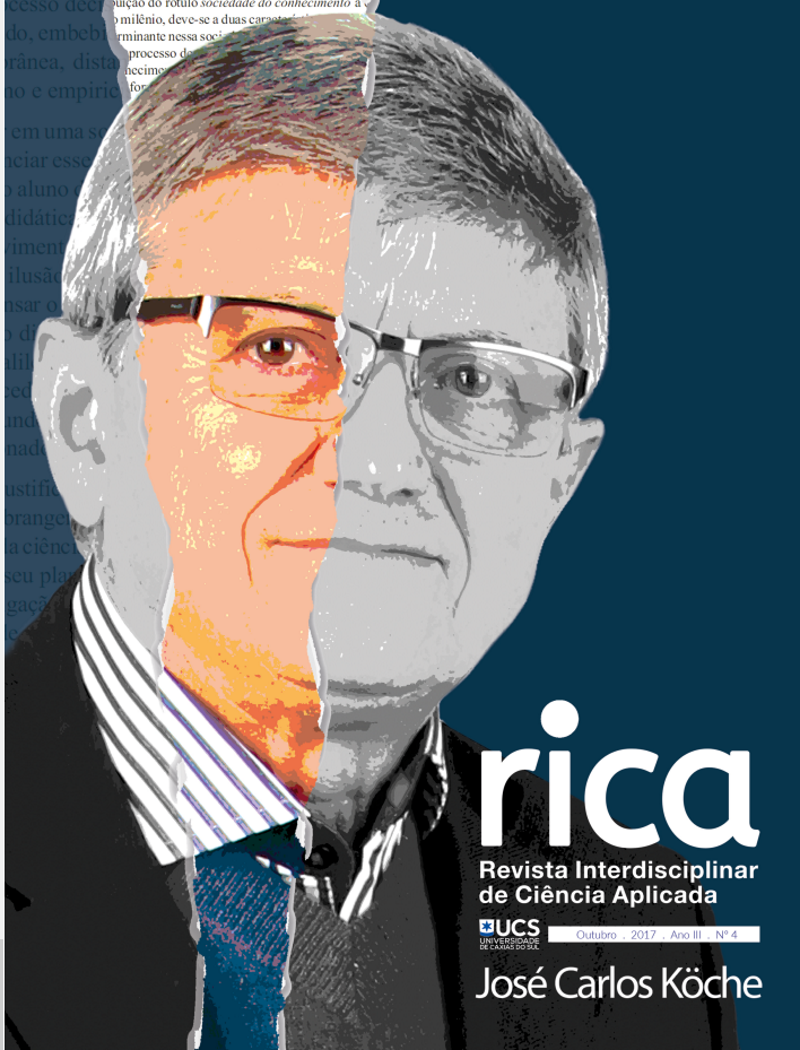Determination of xylem connectivity in Malus × domestica dormant gems through dye application
Keywords:
twigs, dormancy, xylem conductivity, hydrogen cyanamide, appleAbstract
Temperate fruit trees, such as apple (Malus × domestica Borkh.), are characterized by the establishment of bud dormancy. Bud dormancy is overcome after exposure to a certain amount of chilling hours (under 7,2 °C), which varies according to species and cultivars. Another feature of bud dormancy is the lack of free water in buds. In regions where chilling exposure is not enough for dormancy overcoming, the application of chemical substances is necessary in order to break dormancy and for even bud break. One of the difficulties faced by growers is to identify the proper timing for the application of those chemical products. In this work, the water transport in buds during dormancy was assessed, with the intent of evaluating the use of patterns of hydrophilic dye uptake as a marker for dormancy status. As plant material, apical twigs of contrasting chilling requirement cultivars were used. 'Castel Gala' which shows a low chilling requirement for bud break and 'Gala Standard', a high chilling requirement cultivar. These materials were subjected to two experiments: evaluation of water status in buds harvested monthly in the field and under forcing conditions for bud break. Dye capitation, water content, and maximum bud break of apical buds were evaluated. The conductivity of the hydrophilic dye on dormant buds and stems is shown to be reduced during winter. Water content and dye uptake are higher during summer and after bud outgrowth than during dormancy, and both increase after hydrogen cyanamide application. However, there was no difference between ecodormant and endodormant buds in relation to water content and conductivity.
References
LEVANTAMENTO SISTEMÁTICO DA PRODUÇÃO AGRÍCOLA. Rio de Janeiro: IBGE v. 25 n. 2, p. 1-88, 2012. Disponível em: http://www.ibge.gov.br/home/estatistica/indicadores/agropecuaria/lspa/lspa_201202.pdf>. Acesso em: 16 mai. 2013.
PETRI, J.L.; PALLADINI, L.A.; POLA, A.C. Dormência e Indução da Brotação da Macieira. Manual da Cultura da Macieira. EPAGRI, p. 261-298, 2006.
LANG, G.A; EARLY, J.D; MARTIN, G.C.; DARNELL, R.L. Endodormancy, Paradormancy and Ecodormancy: Physiological Terminology and Classification for Dormancy Research. Hort Science, v. 22, p. 371-377, 1987.
HORVATH, D.P; CHAO, W.S.; FOLEY, M.E. Knowing When to Grow Signals Regulating Bud Dormancy. Trends in Plant Science, v. 8, n. 11, p. 534-540, 2003. Disponível em: <http://naldc.nal.usda.gov/download/48125/PDF>. Acesso em: 16 mai. 2013.
ROHDE, A; BHALERAO, R P. Plant Dormancy in the Perennial Context. Trends In Plant Science, v.12, p. 217-223, 2007.
BOTELHO, R V; MULLER, M M L. Evaluation of Garlic Extract On Bud Dormancy Release Of ‘Royal Gala' Apple Trees. Australian Journal of Experimental Agriculture, v. 47, n. 6, p. 738-741, 2007. Disponível em: <http://www.cpatsa.embrapa.br/public_eletronica/downloads/OPB1243.pdf>. Acesso em: 16 mai. 2013.
MIELE, A. Efeito da Cianamida Hidrogenada na Quebra de Dormência das Gemas, Produtividade do Vinhedo e Composição Química do Mosto da Uva Cabernet Sauvignon. Pesquisa Agropecuária Brasileira, v. 26, n. 3. p. 315-324, 1991.
DENARDI, F; SECCON, J J. 'Castel Gala' – Mutação da Macieira 'Gala' com Baixa Necessidade de Frio e Maturação Precoce. Revista Agropecuária Catarinense, v. 18, n. 2, p. 78-82. 2005.
ANZANELLO, R. Fisiologia e Modelagem da Dormência de Gemas em Macieira. 281 f. 2012. Tese de Doutorado (Programa de PósGraduação em Fitotecnia), Faculdade de Agronomia, Universidade Federal do Rio Grande do Sul, Porto Alegre, 2012.
UMEBAYASHI, T.; UTSUMI, Y.; KOGA, S.; INOUE, S.; SHIIBA, Y.; ARAKAWA, K.; MATSUMURA, J.; ODA, K. Optimal Conditions for Visualizing Water-Conducting Pathways in a Living Thee by Dye Injection Method. Thee Physiology, v. 27, p. 993-999,2007.
FAŸ, E.; VACHER, V.; HUMBERT, F. Water-related Phenomena in Winter Buds and Twigs of Picea abies L. (Karst.) until Bud-burst: A Biological, Histological and NMR Study. Annals of Botany, v. 86, p. 1097-1107. 2000. Disponível em: <http://aob.oxfordjournals.org/content/86/6/1097.full.pdf#page=1&view=FitH>. Acesso em: 8 jun. 2013.
RINNE, P.L.; WELLING, A.; VAHALA, J.; RIPEL, L.; RUONALA, R.; KANGASJÄRVI, J.; VAN DER SCHOOT, C. Chilling of Dormant Buds Hyperinduces FLOWERING LOCUS T and Recruits GA-Inducible 1,3-β-Glucanases to Reopen Signal Conduits and Release Dormancy in Populus. The Plant Cell. v. 23, p. 130-146, 2011. Disponível em: <http://www.plantcell.org/content/23/1/130.full.pdf#page=1&view=FitH>. Acesso em: 8 jun. 2013.
SETTIMI, L.; MARCELLO, I.; DAVANZO, F.; FARAONI, M.D.; MICELI, G.; RICHMOND, R.; CALVERT, G.M.; Update: Hydrogen Cyanamide – Related Illnesses – Italy, 2002-2004. Morbidity and Mortality Weekly Report, v. 54, n. 16, p. 405-408, 2005. Disponível em: <http://www.cdc.gov/mmwr/preview/mmwrhtml/mm5416a3.htm>. Acesso em: 30 mai. 2013.
WEINBERGER, J.H. Chilling requirements of peach varieties. Proceedings of the American Society for Horticultural Science, Geneva, v. 56, p. 122-128, 1950.
IUCHI, V. L. Botânica e fisiologia. In: EPAGRI. A cultura da macieira. Florianópolis: Epagri, 2006. p. 59-104.
TREJO-MARTÍNEZ, M.A.; OROZCO, A.J.; ALMAGUERVARGAS, G.; CARVAJAL-MILLÁN, E.; GARDEA, A.A. Metabolic activity of low chilling grapevine buds forced to break. Thermochimica Acta, v. 481, p. 28-31, 2009.
SMITH, A.M.; COUPLAND, G.; DOLAN, L.; HARBERD, N.; JONES, J.; MARTIN, C.; SABLOWSKI. R.; AMEY, A. Plant Biology. 1ª Ed. New York: Garland Science, 2010. p. 679.437- 483, 2010.
RINNE, P; TUOMINEN, H; JUNTTILA, O. Seasonal changes in bud dormancy in relation to bud morphology, water and starch content, and abscisic acid concentration in adult trees of Betula pubescens. Tree Physiology, v. 14, p. 549-561, 1993.
WELLING, A.; RINEE, P.; VIHERÄ-AARNIO, A.; KONTUNENSOPPELA, S.; HEINO, P.; PALVA, E.T. Photoperiod and temperature differentially regulate the expression of two dehydrin genes during overwintering of birch (Betula pubescens Ehrh.). Journal of Experimental Botany, v. 55, n. 396, p. 507-516, 2004.
MAUREL, K.; LEITE, G.B.; BONHOMME, M.; GUILLIOT, A.; PETEL, G.; SAKR, S. Trophic Control of Bud Break in Peach (Prunus persica) Trees: A Possible Role of Hexoses. Tree Physiology, v. 24, p. 579-588, 2004.
VIÉMONT, J. D. CRABBÉ, J.WATER. Dormancy in plants: from whole plant behaviour to cellular control. 1ª ed. Cambridge: CABI publishing, 2000. p. 109-120.
MARAFON, A.C.; HERTER, F.G.; HAWERROTH, F.J. Umidade ponderal em tecidos de pereira durante o período de dormência sob condições de inverno ameno. Pesquisa Agropecuária Brasileira, v.46, n.9, p.1006-1012, 2011.
OPHIR, R.; PANG, X.; HALALY, T.; VENKATESWARI, J.; LAVEE, S.; GALBRAITH, D.; OR, E. Gene-expression profiling of grape bud response to two alternative dormancy-release stimuli expose possible links between impaired mitochondrial activity, hypoxia, ethylene-ABA interplay and cell enlargement. Plant Moleclar Biology, n. 71, 403-423, 2009.
Downloads
Published
How to Cite
Issue
Section
License
Copyright (c) 2021 Interdisciplinary Journal of Applied Science

This work is licensed under a Creative Commons Attribution-NonCommercial-NoDerivatives 4.0 International License.
Authors keep the copyright and cede to the journal the right of publishing first. Published works are licensed under a Creative Commons Attribution 4.0 International (CC BY 4.0) license, allowing the sharing of the work with recognition of the authorship and initial publication in this journal.






